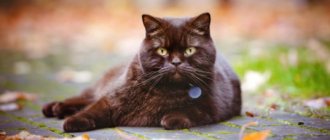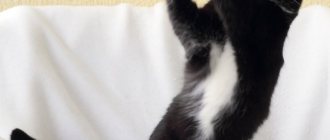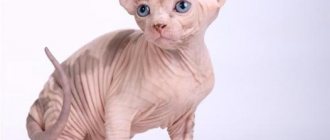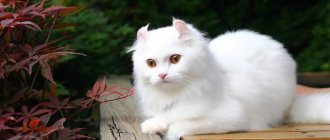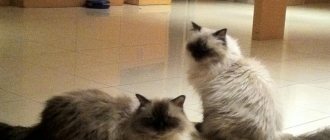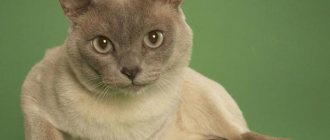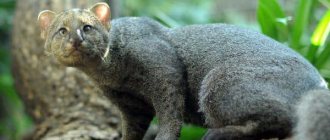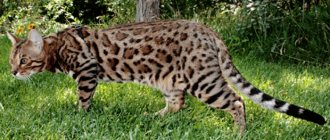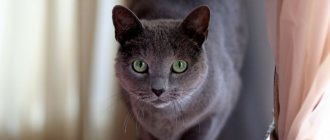History of the origin of cats of the British chinchilla breed
Almost all British cats have a fairly long and rich history, and this developmental feature gives them the advantage of good health and a balanced, playful disposition. Most often, they were born within the maritime state, but sometimes breeders worked in other European countries.
In the nineteenth century, many English cat breeds were already formed, breed standards were established, and special exhibitions began to be held.
Officially, international organizations have mentioned British silver chinchillas since the twentieth century. Around the same time, people's adoration and world fame came to them.
British chinchillas have magnificent fur. The thick and soft undercoat is combined with an incredible shade of the fur coat. All this was passed on to British chinchillas by their ancestors - Persian chinchillas, as well as other cats with uniform coats.
The breeders decided not to stop and continue making achievements. The animals' eye color was far from ideal, as the British chinchilla kittens gradually changed from turquoise-green to green-yellow. Initially, breeders decided to breed existing chinchillas with tabby cats.
This greatly spoiled the color of the coat - stripes and spots appeared on the fur, completely eliminating its purity. Later, these cats began to be crossed over different generations, periodically diluting them with Persians.
In addition to the British silver chinchilla, an unusual golden color was also bred in Great Britain. The process of breeding British golden chinchillas was carried out in exactly the same way, but the difference was in the selection of lighter cats that had been bred before.
Character traits
Golden chinchillas have inherited all the character traits of the aristocratic British.
We can say that British chinchillas are very mannered and at the same time calm animals. They prefer to rest a lot, eat and play on a schedule. They cope well with times when they are left alone.
It is quite difficult to get along with representatives of other cat breeds, but they get along much better with dogs and other animals in the house.
You can train your British cat to use a litter box without any problems. They do not beg food from their owners, considering this inappropriate for their behavior, and do not wake everyone up in the morning.
They are playful at any age, but prefer to play with their owner. They themselves are inactive. Golden chinchillas are very affectionate, but do not tolerate constant cuddling from children. If they are tormented, they may hide and be offended for a while.
Description of British Chinchilla cats
British chinchillas have different fur colors, the main ones are listed below:
- British golden chinchilla;
- British silver chinchilla;
- cream British;
- British shaded;
- British smoky
The real pride of these pets is their beautiful emerald-colored eyes. According to the exhibition criteria, British dogs can also have yellow eyes, but they must certainly be combined with black or smoky fur. Almost all cats of this breed have dark rims around their eyes.
A light coat usually goes in combination with a dark nose and paw pads.
In British golden chinchillas, not all of their coats have a golden hue. On the back, sides and tail of the British Golden Chinchilla the color is darker, and on the chin, belly and neck it is completely peachy.
British women are very strong in appearance, they have a powerful neck. Cats of this breed have a flat, not particularly long back, as well as a wide chest. Their legs are muscular and their hips are somewhat round. In addition, chinchillas have a thick tail with a rounded end.
Males have dense and large cheeks, with which they immediately stand out. The most obvious advantage is the huge expressive round eyes. They do not sit very deep and are approximately the same distance from each other.
Scottish chinchilla, comparison with the golden chinchilla breed, features of the breed
The Scottish chinchilla (cat/cat) differs in character from other representatives of the subspecies. The ears should be compact, lop-eared and tilted forward in accordance with the breed standard.
British chinchilla, golden or silver cat-British
The coat is medium length and has a plush feel to the touch. The undercoat is white, the paw pads are dark. The eyes, lips and edges of the nose of the Scots are outlined in black, which visually makes them stand out.
The muzzle should be chiseled and large in size, the ears should be pressed tightly to the head.
Unlike the golden chinchilla, the Scottish subspecies has a more docile character and is the owner of a rarer color.
Interesting! The Scottish Chinchilla cat is bred in only two categories (by color): shaded and ticked.
Ticked dyeing is incomplete painting of fur hairs. It consists of at least 3 primary colors that correspond to a specific color. Among the Scots, ticked kittens are quite rare. They cost much more than the regular or shaded color type.
Shaded type of coloring is a type of coloring in which only 1/3 of the cat’s hairs (on top) are painted dark. The rest is completely white. This means that representatives of such an unusual shade have a white (or light) undercoat. The shaded part of the color extends to the back, tail (lower part), tummy, muzzle, ears and head.
Fold-eared chinchilla
Scottish Golden Chinchilla Scottish Fold
The main color of the wool has a gradient dyeing method. The “golden chinchilla” color extends only to 1/8 of the entire body. The remaining places are either not painted or have a pale tone. The main color pigment is usually concentrated in the animal's undercoat.
Scottish Silver Chinchilla Scottish Fold
Kittens are not born with a silvery coat. Baby fluff is bright white. When babies are 2 weeks old, the fur begins to acquire a characteristic grayish tint. By 3 months, the ears begin to droop. The Scottish Silver Chinchilla is highly valued by breeders.
Important! Not all kittens in a litter will have floppy ears. All representatives are born with erect ears, which may bend by 3 months, or may remain erect. Fold-eared babies will be classified as Scottish Folds, and straight-eared babies will be referred to as Scottish Straights.
Scottish fold chinchilla
Scots may have green eyes according to the breed standard. Sometimes kittens with blue irises are allowed.
Interesting! Babies can be born with blue eyes, but the shade and color changes until the cat is 2 months old.
British chinchilla
Scottish Straight, golden chinchilla color
The color has a slight shaded dark or black color on many parts of the body. Thoroughbred representatives are distinguished by a gradient color: from a pale peach color there is a smooth transition to darkened (black) tips of the coat. The characteristic golden hue should be evenly distributed over the cat’s body, and not completely paint over a specific area. The formation of stains is unacceptable.
Scottish Straight, silver chinchilla color
Just like the Scottish Fold, it has a snow-white color without spots or dark hairs. There is dark eyeliner on the eyes, nose and ears, which makes the muzzle visually more pronounced. Ticked coat color is very rare, so the price for a cat will increase significantly.
Personality of British Chinchilla cats
These British are true aristocrats. They are quite calm and have patience. The British chinchilla will make friends with all household members without scratching the furniture or meowing too persistently and loudly. A balanced disposition allows them to establish contacts with children. If such a cat gets angry, it will not release its claws or hiss, but will simply disappear from view.
They have independence. The cat does not like it if someone tries to take away its freedom or territory. In addition, they do not like punishment and scolding, showing their stubbornness in response. If you check the reviews of lovers of such cats, you can find out that if the pet does not want to eat or play, it is impossible to force it. You can appease this pet only with tenderness and a bit of cunning.
Basic moments
- Felinological systems do not recognize chinchilla cats as an independent breed, so representatives of this family are registered as Persians, British and Scottish.
- The most valuable and, accordingly, expensive color of chinchillas is gold. Animals with silver fur are considered cheaper and are more common.
- Almost all chinchilla cats are calmer and softer in character than their relatives who have classic coat colors.
- Free-running for chinchillas is strictly contraindicated. These are 100% indoor pets, for whom the street is a continuous series of dangers and mortal threats.
- British and Scottish straight-eared chinchillas have the best health. Persians and Scottish Folds are more susceptible to illness.
- Animals do not require complex grooming care. You will only have to tinker with representatives of the Persian variety, which have very long hair and suffer from excessive tearing.
- Chinchillas are quite intelligent and disciplined, so even an owner without experience can instill in them the basics of cat etiquette.
- These cats have a phlegmatic temperament: they do not annoy with loud meows, do not try to conquer furniture modules and do not arrange archaeological excavations in pots with indoor plants.
The chinchilla is a good-natured creature of silver or gold color, whose main task is to please the owner with his touching appearance and exemplary behavior. Unobtrusive, but extremely affectionate, chinchillas are the type of pet that will never bother you with pranks or violate established boundaries. Accordingly, if you need a well-mannered and slightly phlegmatic friend, place a chinchilla cat in your home - warm relationships and peace are guaranteed!
British chinchilla cat care
Gentle Britons do not require special care. Breeders advise giving your pets regular exercise. Chinchillas enjoy energetic play. There should definitely be a scratching post in the house.
Cats should be brushed at least once a week, and long-haired cats should be brushed three times a week. A good option is to treat your pet’s fur coat using cat whitening shampoos and conditioners that improve the color and quality of the coat.
Sometimes it is necessary to check the ears as well. If necessary, they are treated with a swab moistened with water or a decoction of herbs. To take care of its teeth, your cat must eat solid food.
Contents of a gold Briton
Golden cats of the British breed are suitable for keeping both in a private house and in an apartment. Due to the peculiarities of the coat, shedding in representatives of this breed is almost unnoticeable, especially if it is combed in a timely manner.
Nutrition
Chinchillas can be fed prepared food or natural food.
Important! Under no circumstances should you mix natural food and prepared food. The same prohibition applies to several types of food.
When choosing a dry diet, it is better to focus on super premium or premium classes. Some manufacturers produce lines of food designed specifically for representatives of British breeds, taking into account their needs.
If the owner opted for a natural diet, it should include products such as:
- Raw meat (better lean: veal, turkey). Before serving, it should be placed in the freezer for 12 hours, then doused with boiling water to disinfect it.
- Offal (liver, lungs) boiled or steamed.
- Boiled fish (without bones).
- Low-fat fermented milk products.
- Eggs (preferably quail), 2 times a week.
- Cereals (rice, buckwheat, etc.).
- Vegetables.
The following should be excluded from your pet's diet:
- smoked meats, sausages;
- canned food;
- salty, spicy foods;
- raw milk.
Chinchillas' diet must be balanced. If the animal prefers natural food, vitamin complexes should be added to it from time to time. Drinking water should always be located near the food bowl . It should be changed daily.
How many times a day should you feed your cat?
Chinchillas are prone to overeating and subsequent obesity.
These animals do not know moderation in food, and therefore the dose of delicacy offered to them should be accurately measured. If we are talking about dry food, its quantity must correspond to the data in the table on the package. The amount of natural food is calculated based on the weight and activity of the pet. Leftovers left uneaten by the animal are immediately removed from the bowl. Small kittens eat 6 times a day. Gradually, the number of feedings is reduced, and the animals switch to the feeding regime of an adult cat. The latter are fed 2-3 times a day in small portions.
Walks
The number and duration of promenades depends on the cat's temperament. Some golden pets are content to stay indoors; they are not at all drawn to the street. And other four-legged animals are not at all averse to getting to know the world outside the home.
A chinchilla should be walked on a leash. Before going for a walk, you should take care to protect your animal from parasites. Collars, drops and other means are suitable for this purpose.
Toilet
The golden British chinchilla visits a tray of any size and capacity. Since animals are quite impressive in size, it is better to choose a stable and large toilet for them. Any filler can be used.
Advice. When training a kitten to use the toilet, at first you should purchase the litter that the baby is accustomed to in the nursery. A conscientious breeder, when transferring the baby to a new owner, will provide the latter with all the necessary information.
Reviews of British Chinchilla cats
- Natalia.
In love with this breed. My British chinchilla cat is two years old. He is wayward and smart, a real aristocrat. He eats premium food and also respects boiled chicken and egg whites. Loves to talk both with people and with himself. He only sits in my arms and sleeps in his own place. Loves boxes. He is not afraid of the hairdryer and vacuum cleaner, but plays with his toys. Below is a photo of my British chinchilla.
- Nadia.
Our Vasilisa immediately learned to use the tray. She is very smart, gentle and affectionate, a little annoying, but not at all aggressive or angry. The downside is that he likes to steal from the table, but he hasn’t been able to stop it yet. Although elegant, she is quite nimble. We love her very much!
Nutrition
To keep your pet's coat in good condition, the British chinchilla needs special nutrition. The best option is dry food. It is chosen depending on the age and gender of the pet.
Castrated and sterilized animals require special food. Manufacturers produce food for such animals. If feeding is homemade, it should be low-calorie, since processed animals are famous for their large appetites and are prone to becoming overweight. In addition, their hormonal levels are disrupted and this is taken into account when feeding.
If you plan to use homemade food, the chinchilla’s menu should include cereals, meat, fish (sea, as river fish can have parasites), and vegetables. Raw meat should not be given to cats. The product may contain worm eggs, and the animal will become infected with parasites.
A Briton should have constant access to clean water and his dishes should always be clean.
To keep their fur in good condition, cats are given eggs. Natural proteins and protein strengthen the roots, hairs do not grow so abundantly. With this diet, the fur of a silver or golden chinchilla becomes shiny and denser. Quail eggs are preferable to chicken eggs. But not everyone can afford to feed their cat quail eggs.
British chinchilla nurseries
You can buy a good British chinchilla from a good nursery. When visiting a British chinchilla nursery, you should pay attention to how it looks: whether the walls are clean, what smell is in the room, what the cats eat and what their litter box looks like, whether they have toys, and so on.
You need to make sure that the nursery has a license and status.
The price of British chinchilla kittens in the nursery is high, on average - from three to forty thousand rubles.
Nurseries where you can buy British chinchillas:
- Ilios Cats;
- Vivian;
- Devinor;
- La Mur Cat.
Price
The price of any Scottish kitten depends on many factors: gender, type of ears (loose-eared kitten or straight-eared), color, purpose of its acquisition (as a pet or for breeding), its state of health (whether its parents have tests), title and fame ancestors, etc.
If we are talking about Scottish golden chinchillas with the right to breed and for exhibitions, then their price can reach up to several thousand dollars. High-quality Scottish golden chinchillas are very rare. They are expensive.
If we are talking about Scottish golden chinchillas as a pet, then their price is several times lower.
If you like one of our kittens, feel free to contact me. I will tell you more about the kitten itself and its terms of sale.
Health and feeding of British chinchilla cats
Diseases to which the British chinchilla is susceptible:
- anorexia;
- lack of interest;
- weakening of heartbeat;
- difficulty breathing;
- paralysis of the hind legs;
- hemophilia.
The British chinchilla can be fed natural food. It must include:
- sea fish;
- lean meat;
- milk;
- bird;
- cereals;
- vegetables and fruits.
When purchasing ready-made food, it is necessary to take into account all the individual characteristics of your pet.
This lovely pupil will decorate any home. She will always bring happiness and joy to the house, especially if you take care of proper care and a balanced diet.
Maintenance and care
For the happiness of keeping such a handsome chinchilla Persian in the house, the owner will have to pay with special care. Long hair tends to form clumps and tangles, so these pets require daily care.
Combing with a furminator becomes a systematic procedure. In addition, to maintain the white color of the fur, it is necessary to use special whitening shampoos, which will preserve the white color and prevent the cats from turning yellow.
Specifics of keeping chinchillas:
- Brushing every day.
- Watery eyes.
- Special shampoos for white color.
The food must be of high quality, with a set of necessary vitamins and nutrients. This is necessary both for the health of the animal and for maintaining the coat in good condition.
Due to the fact that chinchilla cats have tears, their eyes must be washed frequently with special solutions. With good care, animals of this breed live 12-15 years.
Chinchilla Persian cats are distinguished by their beauty and kind character. They will delight their owners with playfulness, but are jealous and ready to follow on their heels. And although these animals require care and attention, the pleasure from communicating with them is much greater.
British chinchilla. Photo
5 / 5 ( 1 voice )
White-pink
This color is obtained by crossing white Wilson and heterobeige chinchillas. It, in turn, is also divided into 2 types: heterozygous and homozygous. The white-pink heterozygous chinchilla has a white coat with beige spots of different sizes and locations. Sometimes only the ends of the hairs are colored beige, which creates the effect of a pinkish veil. The ears and nose are pink, but sometimes there are small beige spots on the ears.
The homozygous type of white and pink chinchilla is quite rare, due to which it is highly valued. Animals differ from the heterozygous form in that they have a predominant white color, pure pink ears without spots, and red eyes. Clearly limited beige and golden spots with this color are considered very rare.
